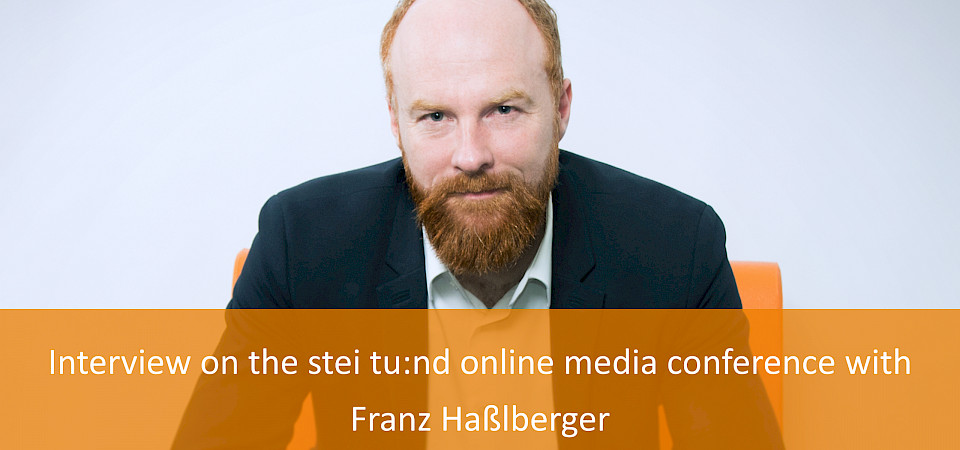
Digital trends for media companies: An interview on the media conference
In recent months, everyone has understood the value of reliable news. From information on regulations, to case numbers to changing habits. Editors informed us about decisions of politicians and researchers' discoveries. Online as well as offline, in- or on-ear via podcast or on your smartphone as news app. Technical innovations such as the cloud, newsroom and hosting areas serve as a basis for media companies. SInce digitization is running ever faster, it is time to take a breath. At the stei tu:nd online media conference, we take an intensive look at digital trends in the media environment together with media experts. In an interview with Franz Haßlberger, Head of Business Division Media, we look at current challenges of the media industry and learn more about the focus of the media conference.
In the jambit Business Division Media, you have been supporting media companies for many years in various software development projects. How did the demands on editorial offices change?
When we introduce a new editorial system with a partner, we do not only deal with technical questions but also with actual users, in our case the editors of the publishing houses. Talking to the editors, we notice that they are mainly confronted with high time pressure and a heavy workload. The importance of up-to-dateness and fast content production and distribution is particularly evident now. The life cycle of content and how it is personalized, planned and distributed is changing. The focus is on the reader's benefit and structures to cast this benefit into suitable content formats are needed. But also subscription model concepts for monetization. Editors need the right working conditions for this. Efficient digital tools to support them optimally, take unnecessary work steps off their hands and make their lives easier overall.
What is your focus for the upcoming media conference?
We would like to present a wide variety of media companies and their solutions at the conference. Everything rangig from classic publishing houses to TV stations will be represented. At the stei tu:nd online conference, visitors will learn how the F.A.Z. uses a machine learning concept to determine which articles are most relevant for the paywall and how the Bayerische Rundfunk uses language assistants such as Alexa or Google Home for interactive storytelling. Our partners from RedaktionsNetzwerk Deutschland or SWMH will also host program items.
When introducing new publishing systems, you are confronted with the requirements of the editorial offices. What do digital solutions have to offer to really advance journalism?
By merging their editorial offices, publishing houses create structures that function more flexibly and can be controlled centrally. Online and print departments grow together, regional publishers bundle the production of full-run pages and supra-regional content, etc. This creates new challenges for which new new publishing systems like Arc Publishing must provide answers. Modern tools such as article editors, which can compete with Google Drive in terms of UX and collaboration. The pooling of content across publishing house boundaries is also a crucial aspect. The diversity of formats also requires seamless integration of image, video and audio management to avoid tool changes and media disruptions. Furthermore, recommendation engines that support editors with active and passive recommendations for user-centered offerings. It is our mission as software service providers to help media companies choosing the right tool.
And how does jambit experience the higher requirements? For FAZ.NET, jambit is responsible for the operation and further development of the platform.
Strong demand has brought online brands of daily and weekly newspapers enormous growth in terms of access numbers and reach. As a result, the development towards online media formats is accelerating. Overall, this creates high demands on the stability and flexibility of the publishers' IT infrastructures. Because, as in every situation, the load fluctuates greatly, which means that infrastructures have to react efficiently and cost-optimized. FAZ.NET recorded an 80 percent increase in access in March 2020 compared to the previous month. jambit's cloud systems scaled, the editorial team was able to continue working without interruption and the reader did not notice anything of the effort. This wa also a great success for our cross-functional jambit team.
How does digitization change revenue models and how can publishing houses take advantage of the current situation and turn readers into customers?
The classic sale of advertising in print and online is only suitable to a limited extent. Advertising revenues have been declining steadily for years anyway, but have collapsed massively overnight as a result of the pandemic. On the other hand, the situation represents a tremendous opportunity for digital subscription models of publishing houses. The immense growth in trial subscriptions makes this clear. Publishing houses must now seize this opportunity by optimizing their subscription offers, building an effective sales funnel, and investing in reader retention. Media decision-makers can experience how this works at our conference.
All information on the stei:tund media conference at a glance:
- WHO? Various speakers from renowned media companies such as F.A.Z. and SWMH, BR or RND
- WHAT? stei tu:nd – the jambit media conference on solutions for the digital future of media
- WHEN? Thursday, November 12, 2020
- WHERE? Online via live-streaming


![[stei tu:nd] – Die jambit Medienkonferenz](/site/assets/files/10801/stay-tuned-_stei-tund_-jambit-medienkonferenz.-widemedium.jpg)
